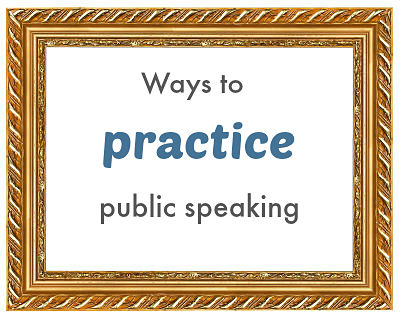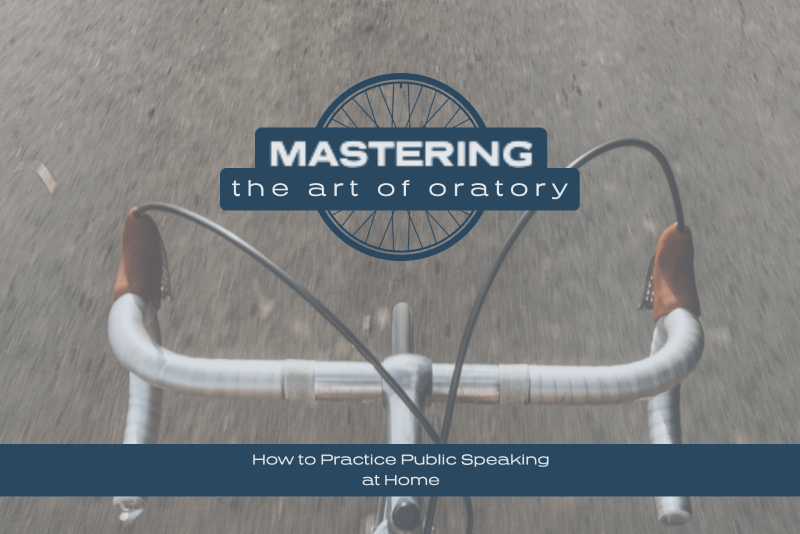Public Speaking Exercises
 Practice Public Speaking Exercises at Home to Build Your Skill and Confidence Muscles
Practice Public Speaking Exercises at Home to Build Your Skill and Confidence MusclesContents
Six Effective Ways to Improve Your Speaking Skill
Public Speaking Exercises to Overcome Nerves and Improve Style
Physical Speech Exercises to Improve Vocal Ability
How can you practice public speaking from home? We suggest several exercises below that will help you overcome anxiety and speak confidently.
Sooner or later, you will have to speak in front of a significantly large audience. Will it be your 15 minutes of fame… or will it be your 15 minutes of shame? Worry not, as there are a number of public speaking exercises that will prepare you for that big opportunity.
Are you afraid that you might forget your lines? Concerned that you might stutter? Worried that you might say something inappropriate? Believe it or not, most public speakers – even the veterans – have the same fears. Yet, they manage to deliver their pieces successfully, with the audience completely unaware of their anxiety!
If they can do it, so can you.
On this page you'll find some public speaking exercises you can do in the comfort of your own home. Practice these regularly and there is no reason why people won’t love what you’ll say and how you’ll say it!
Public Speaking Exercises to Improve Comfort in Front of an Audience

Public Speaking Exercise #1 - Mirror image
Most public speaking fears stem from the fact that while on stage, we won’t be able to see ourselves. Hence, we tend to assume the worst. "My hair might be messy," or "there might something coming out of my nose," or "my tie might be improperly knotted" are just some of the things public speakers think of when delivering their presentations. Practicing in front of a mirror will condition your mind to visualize how you deliver your speech when the big moment comes. This way, your fears will diminish.
Exercise #2 - Practice in front of family members
Seeing yourself speak in front of the mirror can only do so much. Extend your public speaking exercises even further by speaking in front of a "friendlier" audience: your family. Ask them for suggestions later on so that you may improve your delivery.
Presenting a speech to family members can serve as a valuable exercise for individuals looking to improve their public speaking skills. By practicing in front of a familiar and supportive audience, speakers can gain invaluable feedback, build confidence, and hone their delivery in a comfortable environment. Family members can provide constructive criticism on aspects such as clarity, pacing, and body language, helping the speaker identify areas for improvement.
Additionally, presenting to family members allows the speaker to become more accustomed to maintaining eye contact, engaging the audience, and handling potential distractions.
Practicing in this safe and nurturing setting can significantly reduce anxiety and prepare speakers for a more diverse and potentially larger audience. As the speaker becomes more comfortable delivering their speech to family members, they can incrementally increase the audience size or practice in front of friends or colleagues, further developing their public speaking abilities.
Exercise #3: Record and Review
Record and review is the best exercise to improve public speaking in the opinion of BST. Record yourself delivering your speech, and review the footage to identify areas for improvement. Why? Watching yourself in the mirror does not provide an ability to study the same delivery multiple times. And, we all know that family members are often too encouraging or biased, and, if blunt, can cause temporary discouragement.
The record and review method is a highly effective exercise for individuals preparing a speech and seeking to improve their public speaking skills. By recording themselves delivering the speech, speakers can gain a unique perspective on their performance, allowing them to critically assess various aspects such as tone, pacing, body language, and audience engagement.
This self-evaluation process enables speakers to pinpoint areas of improvement, as well as recognize and reinforce their strengths. Watching the recording multiple times, speakers can take note of any verbal fillers, awkward pauses, or unclear articulation that may detract from the effectiveness of their presentation.
Additionally, reviewing the recorded footage can help speakers identify and correct any distracting mannerisms or nervous habits they may not have been aware of.
By regularly recording and reviewing their speeches, speakers can progressively refine their public speaking abilities, ultimately leading to more polished, confident, and engaging presentations.
As you can see, record and review is a powerful tool. And, if you get a family member involved, you can knock out two exercises at the same time.
Public Speaking Exercises to Improve Vocal Ability
Exercise #4 - Practice varying the tone of your voice to emphasize certain points
Here's a little known fact: public speaking is more of an art than a science. It's more of a show than a lecture. More attention is given to how you deliver your piece than to its content. Sad? Perhaps. True? Absolutely! Hence, it is easier to "trick the system," so to speak. Practice assigning a certain tone to important points of your speech. Shout out the lines that are meant to shock the audience, if you have to. Whisper the lines that denote exasperation. There are a lot of public speaking exercises, but this can provide the most immediate results.
REMEMBER: you don't have to memorize your lines for most public speaking engagements. If you memorize each and every word you'll say, you may sound robotic when you deliver your speech. Worse, this might cause you to fumble in finding your words because your tendency is to forget them. Instead, memorize the gist of what you want to say, then practice expressing it spontaneously. Armed with the gist of what you want to share, you'll never lose track when you do get to deliver your speech.
IMPORTANT: create an outline, and rely on it! Most speeches fail because they sound directionless. They're like random lines joined together to create the semblance of length to fill up the time allotted. In the previous exercise, you were asked to memorize the gist of what you want to share. That gist should be incorporated in an outline that should work towards delivering your ultimate point.
For example:
- the first part of your outline should introduce the problem
- the second should discuss the importance of a solution
- the third should present the solution and give details
- the fourth should tell the audience why the suggested solution is the best choice.
Of all the public speaking exercises, this is the most critical.
Exercise #5 - Tongue Twisters
One of the most effective ways to develop public speaking skills is to practice a range of exercises that target different aspects of communication. These exercises are designed to help you develop clarity and fluency among other critical components of successful public speaking.
Why exercise public speaking skills with tongue twisters
Tongue twisters serve as a powerful tool for enhancing vocal clarity and fluency, particularly for public speakers looking to polish their oratory skills. These challenging phrases, which often contain similar or repetitive sounds, compel speakers to concentrate on articulating each word and syllable with precision. By practicing tongue twisters, speakers develop their ability to enunciate clearly and speak more fluidly, even when faced with complex or unfamiliar words. Furthermore, mastering tongue twisters can help speakers build confidence and reduce the likelihood of stumbling over words during a presentation or speech.
How to practice tongue twisters effectively
To practice tongue twisters as a technique for improving vocal clarity and fluency, start by selecting a few phrases that challenge you. Begin with a slow and deliberate pace, enunciating each syllable and focusing on accuracy. Gradually increase your speed while maintaining clarity and precision. If you stumble over words, slow down and try again. Aim to practice daily, and as you become more comfortable with a particular tongue twister, introduce new ones to your routine. This will ensure that you continue to develop your articulation skills and enhance your ability to tackle a wide range of words and phrases with ease. Regular practice of tongue twisters will ultimately contribute to improved vocal clarity and fluency in your public speaking endeavors.
Tongue twisters you can use to improve speaking ability
Here are a few tongue twisters that can help improve your speaking ability:
- Peter Piper picked a peck of pickled peppers. If Peter Piper picked a peck of pickled peppers, where's the peck of pickled peppers Peter Piper picked?
- How can a clam cram in a clean cream can?
- She sells seashells by the seashore. The shells she sells are surely seashells. So if she sells shells on the seashore, I'm sure she sells seashore shells.
- How much wood would a woodchuck chuck if a woodchuck could chuck wood? He would chuck as much wood as a woodchuck would if a woodchuck could chuck wood.
- Fuzzy Wuzzy was a bear. Fuzzy Wuzzy had no hair. Fuzzy Wuzzy wasn't very fuzzy, was he?
- I saw Susie sitting in a shoeshine shop. Where she sits she shines, and where she shines she sits.
- Betty Botter bought some butter, but she said, "This butter's bitter! If I put it in my batter, it will make my batter bitter!" So, she bought a bit of better butter, and it made her batter better.
- A proper copper coffee pot.
Remember to start slow and focus on clarity before gradually increasing your speed. Practicing these tongue twisters regularly will help improve your articulation, enunciation, and overall speaking ability.
Exercise #6 - Vocal Warm-Ups
For vocal warm-ups engage in activities such as humming, lip trills, or sirens to prepare your vocal cords and enhance your vocal range.
Humming is a simple yet effective vocal warm-up that involves producing a continuous sound with your lips closed, allowing the vibrations to resonate within your facial and chest cavities. This exercise helps to relax the vocal cords, improve breath control, and gently warm up the voice before speaking or singing. By focusing on maintaining a steady and comfortable pitch while humming, you can also develop better pitch awareness and control.
Lip trills, also known as lip bubbles or lip rolls, involve blowing air through closed lips to create a buzzing sound while maintaining a consistent vocal pitch. This exercise helps to release tension in the facial muscles, lips, and jaw while simultaneously warming up the vocal cords. Lip trills also promote healthy breath support, as they require the speaker to maintain steady airflow to sustain the buzzing sound. By practicing lip trills, speakers can develop a more relaxed and resonant voice, which is essential for effective public speaking.
Sirens are a vocal warm-up exercise that involves sliding your voice smoothly through your entire vocal range, from your lowest to highest notes and back down again, imitating the sound of a siren. This exercise helps to increase vocal flexibility, strengthen the vocal cords, and expand your vocal range. By regularly practicing sirens, speakers can develop greater control over their voice and its various pitches, ultimately leading to a more dynamic and engaging speaking style.
In addition to these exercises, joining a public speaking group or club, such as Toastmasters International, can provide valuable feedback and support from fellow speakers. Participating in a group setting allows you to practice your skills in a safe environment and benefit from the shared experiences of others who are also working to improve their public speaking abilities.
It is important to remember that overcoming the fear of public speaking and mastering the art of effective communication is a gradual process that requires consistent effort. Be patient with yourself and celebrate small victories along the way. By setting realistic goals and being persistent in your practice, you will see improvements in your public speaking skills over time.
In conclusion, public speaking exercises are an integral part of developing strong communication skills and overcoming the fear of speaking in front of an audience. By practicing exercises that focus on articulation, vocal warm-ups, breathing techniques, body language, and self-evaluation, you can enhance your overall public speaking abilities. Consider joining a public speaking group for additional support and feedback, and remember that progress takes time and dedication. To further develop your skills, consider reading books on public speaking, attending workshops, or enrolling in a public speaking course. With persistence and practice, you will become a more confident and engaging speaker who leaves a lasting impression on your audience.
Practice these public speaking exercises whenever you can and you'll be an accomplished speech-maker in no time.



